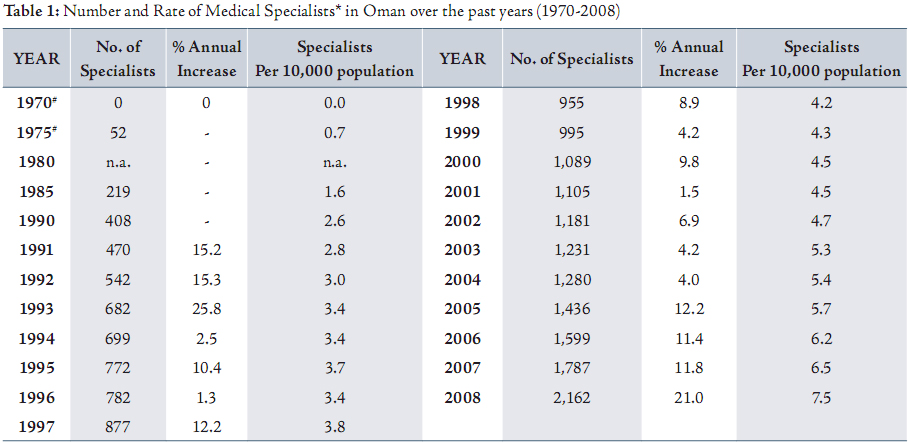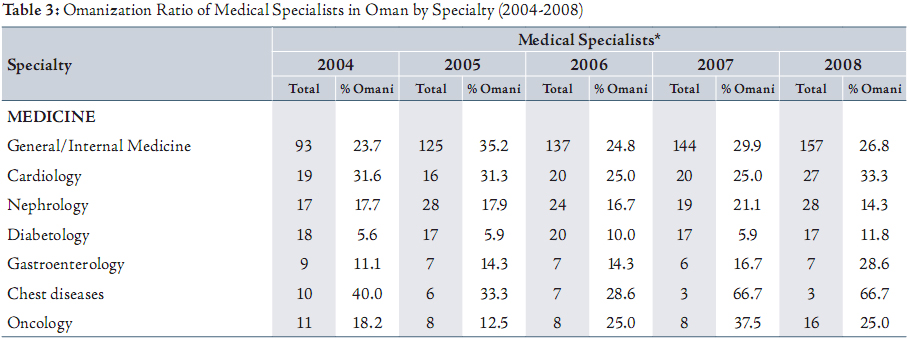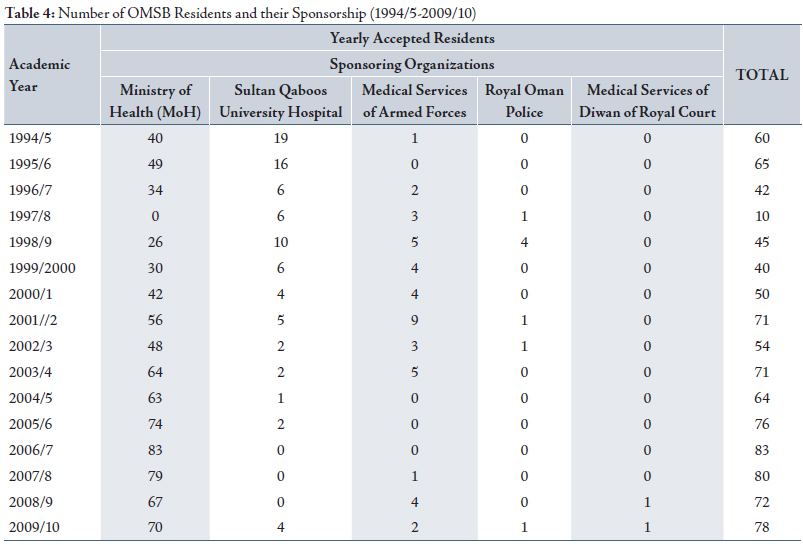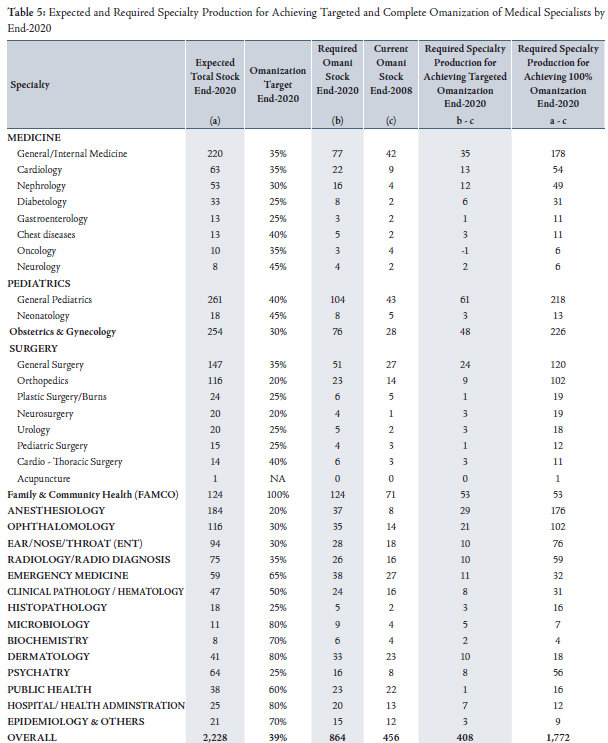Medical Specialties in Oman: Scaling Up through National Action
Moeness Alshishtawy
Alshishtawy M. OMJ. 24, 279-287 (2009); doi:10.5001/omj.2009.57
ABSTRACT
Objectives: To analyze the situation of medical specialists in the Sultanate of Oman, in terms of its past and current size and future needs.
Methods: Data of Oman Medical Specialty Board (OMSB) and Ministry of Health (MoH) on medical specialists in Oman and the current Omanization levels in various specialties were reviewed and analyzed. Projections of the need for medical specialists by the End-2020 and in 2032 were calculated based on three different scenarios.
Results: Data on the number of medical specialists in Oman revealed a steady increase over the years, starting from only 52 specialists in 1975 to 2,162 in 2008; 25.1% of them were Omanis. The ratios of Omanization showed some inconsistency over the years in certain categories of specialization and were considerably low in some important specialties, e.g. Anesthesiology (5.7%) and Obstetrics & Gynecology (18.5%). By the End-2020, the total workforce of medical specialists in Oman is expected to reach 2,228; 408 of them would be Omanis. Otherwise, to achieve 100% Omanization, the number of Omani specialists required would be 1,772. According to three different scenarios, the number of medical specialists in Oman would range from 2,785-4,569 by 2032; of them 1,859-3,646 would be Omanis.
Conclusion: In order to rapidly increase the number of medical specialists in Oman to satisfy the country’s needs, OMSB has to adopt a visionary long-term strategy, through which it wouldß be able to gather all stakeholders resources within a national framework and direct a significant investment of funds towards scaling up medical specialists production.
From Health Planning, Ministry of Health, Sultanate of Oman.
Received: 03 Aug 2009
Accepted: 08 Sep 2009
Address correspondence and reprint requests to: Dr. Moeness Alshishtawy, Health Planning, Ministry of Health, Sultanate of Oman.
E-mail: drmoness@gmail.com
INTRODUCTION
The importance of health workers for health systems performance, quality of care, achieving the health-related Millennium Development Goals and for scaling up effective health interventions, is widely recognized.1,2,3 However, in 2006, there was a global shortage of health workers estimated at more than 4 million, including both clinical, administrative and logistics staff at all systems levels.4,5 This shortage of human resources for health has replaced funding shortfalls as the most serious obstacle to implementing health plans.6 Training, sustaining and retaining a motivated and supported workforce requires long-term commitment, structural and fiscal changes, and partnerships at country, regional and international levels.7 The purpose of the human resources for health (HRH) planning process is to seek a balance or to address the mismatches between what is available in terms of HRH and what is actually required to deliver the health services.8
In Oman, interest in human resources development has been a priority for the past few decades as a strategy for achieving effective health services development. Accordingly, human resources availability in the Sultanate has grown significantly over the years. Intentionally, Oman is keen to achieve total self-reliance in the physician category including the medical specialties, so it kept pursuing policies and plans over the past years for that purpose. However, progress in Omanization in the medical specialties has been relatively slow because of the long gestation lag and a multiplicity of other factors.9 Responding to the country’s needs, the Oman Medical Specialty Board (OMSB), since its establishment in 2006, has become responsible for achieving a rapid scaling up of the production of medical specialists, and for establishing and strengthening partnerships with institutions in developed countries in the area of education and training in order to balance the supply and demand for various medical specialties and sub-specialties in Oman.
This study aims to analyze the past and current situation of medical specialists in Oman in order to determine the number of candidates that should be recruited under OMSB or sent for overseas education in different medical specialties to achieve the country’s targets. This study also intends to recommend – based on its findings - the essential requirements that would enable OMSB to embrace significant change on the situation of medical specialties in Oman.
METHODS
In this article, the Oman Medical Specialty Board (OMSB) and Ministry of Health (MoH) data on medical specialists in Oman were reviewed. Data about the overall workforce of medical specialists and the current Omanization levels in various specialties were obtained from the Annual Health Reports of MoH. Other data was obtained from the Department of Planning, and the Department of Information and Statistics, Directorate General of Planning, Ministry of Health.
The data included information about number of specialists needed for new projects included in the 8th and 9th 5-Year Plan for Health Development (2011-2002), unfilled specialists posts, estimation of the likely growth in the Omani specialist manpower in MoH in various specialties beyond the 7th Plan, based on the available information on residents registered under OMSB and those studying abroad, projections of the need for medical specialists in MoH by the end of the 9th plan period - based on estimation of future requirement taking into consideration the intentions of expanding the health system infrastructure, and using UN Medium Variant population projection.10 Production targets of Omani specialists to be achieved by the of 2020 were derived from a systematic assessment of the staff situation in various medical specialties in MoH, the Omanization levels in these specialties, prospective requirement and availability of specialists in various fields, keeping in mind the maximum number required as per Ministry’s 2020 vision.
Projections for Omanization rates were calculated assuming that MoH desired to maintain the estimated ratios for each specialty, in the light of similar projected population figures for 2020. The effect of attrition to the workforce was assumed to be offset by fresh recruitment. Accordingly, the percentage of Omani attrition was assumed to be small.10 Projections for the status of medical specialists by the year 2032 were based on the average annual growth rate of specialists per population, assuming three different scenarios: 0%, 1% or 2% for the increase in the rate and calculating the total number of medical specialists (Omanis and non-Omanis) accordingly.
RESULTS
Table 1 shows the number and rate of medical specialists in Oman during the period (1970-2008). In 1975, the number of medical specialists working in Oman (Ministry of Health, specifically) was only 52 (0.7 per 10,000 population), since then the number has shown a steady increase over years. The rate of increase in the number of specialists showed multiple fluctuations ranging from as low as 1.3 in 1996 to as high as 25.8 in 1993. Another peak increase was recorded in the year 2008 (21%), at which the number of medical specialists in Oman jumped to 2,162 (7.5 per 10,000 population).
Table 1: Number and Rate of Medical Specialists* in Oman over the past years (1970-2008)

* Does not include data of Armed Forces Medical Services
**Specialists include Medical Administrators.
#Figures of 1970 and 1975 pertain to Ministry of Health only.
Source: Annual Health Reports – MoH (Oman) 1995, 1999, 2005 & 2008.
Table 2 depicts the number and Omanization ratio of medical specialists in Oman by place of work. It seemed that the majority of medical specialists were working in the Ministry of Health institutions in 2008 (74.2%), followed by the private sector hospitals and clinics (18.7%), then in other governmental (non-MoH) institutions (7.1%). In the last five years, the number of specialists working in MoH increased from 1,011 to 1,604 (58.7% increase). The rates of increase for specialists working in governmental (non-MoH) and private sector institutions were 35.4% and 159.6% respectively during the same period. Although the least number of medical specialists (153 in 2008) were working in governmental institutions (not including MoH and Armed Forces Hospital), the highest ratio of Omanization was recorded among them (48.4% in 2008). The Omanization ratio for MoH specialists jumped to 28.4% in 2008 in comparison to 22.3% in 2004, while the Omanization ratio among specialists working in private institutions decreased from 3.9% in 2004 to 3.0 in 2008.

* Includes: Royal Oman Police, Petroleum Development of Oman, Sultan Qaboos University Hospital and Medical Services of Diwan of Royal Court
# Data as of 31.12.1993
$ Excludes medical administrators
Sources: Annual Health Reports – MoH (Oman) 1994 & 2004-2008; Human Resources Planning for Medical Specialists: A Future Study, MoH (Oman) 1995.
Information on the number and Omanization ratios of medical specialists employed by the Ministry of Health (MoH) over the years (2004-2008) is shown in Table 3. The table shows generally a steady increase in the number of specialists in the majority of specialties over the years. However, in certain categories of specialization, the number of specialists and Omanization ratios showed inconsistencies during the last five years. The highest number of specialists was recorded in the field of “General Paediatrics” (186 in 2008) and the highest Omanization ratio was recorded among Family and Community Health (FAMCO) specialists (93.4% in 2008).

* Include Specialists/Consultants/Medical Administrators working in Ministry of Health only.
** Include: Quality Control, Health Statistics, Nutrition, and Health Education.
Source: Annual Health Reports – MoH (Oman) 2004-2008, Table 4-16.
In 2008, the lowest number of specialists were working in the fields of acupuncture (2), chest diseases (3), and neurology (5). The lowest Omanization ratio was recorded in the specialties of: Acupuncture (0.0%), Anaesthesiology (5.7%), Neurosurgery (7.7%), Diabetology (11.8%), Urology (12.5%), Nephrology (14.3%), Orthopedics (14.9%) and Ophthalmology (15.2%).
Table 4 shows the numbers of OMSB residents and their sponsorship during the academic years (1994/5 to 2009/10). It seems that Ministry of Health was the main sponsor for OMSB residents with a range of 26-83 resident yearly with the exception of the academic year 1997/1998 when no residents were sponsored by the MoH. Sultan Qaboos University Hospital ranked second in the list especially in the early years since the establishment of OMSB (1994-2000), sponsoring 6-19 residents annually, followed by the Medical Services of the Armed Forces with a total of 43 residents in 16 years, Royal Oman Police (8 residents), and lastly Medical Services of Diwan of Royal Court that sponsored two residents in the last two academic years. The total number of residents sponsored by all organizations showed fluctuations over the years with a significant increase in the academic year 2006/7 to 83 residents.
Table 4: Number of OMSB Residents and their Sponsorship (1994/5-2009/10)

Source: Annual Health Reports – MoH (Oman) 1998-2008, Table 5-7 & Trainee Affairs Section – OMSB & Office of Post-Graduate Medical Training Unit (PGMTU or Old OMSB).
The expected and required specialty production for achieving the targeted and complete Omanization of medical specialists by End-2020 is shown in Table 5. To achieve the targeted Omanization level, an additional workforce of 408 Omani medical specialists should be added to the total workforce (Omani and non-Omani) currently present (by End-2008) to reach an expected total stock of 2,228. On the other hand, to achieve 100% Omanization, the number of Omani medical specialists to be added to the 456 already employed Omani specialists (by End-2008) will be 1,772 in order to reach the expected total stock of 2,228.

Source: modified from reference No. 10.
Table 6 depicts three scenarios for the situation of medical specialists in Oman in 2032. The first scenario projects the number of medical specialists that will be needed to satisfy the health needs of the population assuming that the average annual growth rate of specialists per population equals zero (i.e. remains the same as in 2007 wihout any change). The total number of specialists needed by 2032 in that scenario is 2,785; out of them 1,859 would be Omani. If the average annual growth rate of specialists per population is allowed to increase to 1%, the numbers required will be 3,571 (total) and 2,850 (Omanis) respectively. The third scenario assumes an allowed increase of 2% in the rate. In such a scenario, the total number of medical specialists working in Oman would reach 4,569; out of them 3,646 would be Omanis.

Source: Department of Information and Statistics, Ministry of Health, Headquarter.
Scenario I = Projections assuming an average annual growth rate of medical specialists per population = 0.0%
Scenario II = Projections assuming an average annual growth rate of medical specialists per population = 1.0%
Scenario III = Projections assuming an average annual growth rate of medical specialists per population = 2.0%
DISSUSSION
The case for scaling up the health workforce has been discussed in numerous policy documents. Both the Joint Learning Initiative and the World Health Report 2006 called for a concerted effort to increase the quantity and quality of health workers through education and training.2,4,6 Such an effective action requires solid information, reliable analysis and a firm knowledge base.11,12 In fact, Oman’s health sector pursues a sound approach to human resources development along the lines advocated by the World Health Organization. Moreover, Oman is keen to have baseline information on the past and current size of health workforce as well as its profile and distribution.13,14,15
Reflecting on the situation of medical specialists in Oman, the figures revealed a marked progress. However, the changes over the years were not that sharp, as there was a steady but gradual increase in the number of medical specialists over the past 39 years starting from only 52 in 1975 and reaching 2,162 in 2008. This has led to an increase in the rate of medical specialists per 10,000 population from 0.7 in 1975 to 7.5 in 2008. This rate is considered much lower than that of Saudi Arabia (12.21 in 2007), but very high when compared with rates in other countries of the Eastern Mediterranean (EMRO) Region (5.21 in Tunisia in 2007, 2.84 in Islamic Republic of Iran in 2005, 2.68 in Morocco in 2007, 1.93 in Iraq in 2007, and 1.14 in Yemen in 2007).16,17
No doubt, the increase in medical specialists in Oman was parallel to the increased Omanization levels in all institutions except those of the private sector which still depends mainly on expatriates. Needless to say, the availability of local manpower production facilities in case of physicians and specialists has helped improve the Omanization levels in these professions during the last few decades. Postgraduate medical education commenced in Oman with the establishment of OMSB in 1994. In April 2006, OMSB was reconstituted as an independent body that is responsible for overseeing and promoting the development of postgraduate medical education and training for all specialties across the Sultanate of Oman.18 The newly re-constituted Oman Medical Specialty Board has already embarked on a long-term strategic planning exercise on medical specialty education.19 OMSB’s First Strategic Plan is expected to produce the mapping for five years (2011-2015) and which should contain a detailed situation analysis of the past and current status of medical specialty education, further potentials of its development in the light of analysis of future requirements of medical specialists in diverse fields.
Looking at the situation in the Ministry of Health, being the main consumer of medical specialists in Oman – employing nearly three quarters of specialists - the leading specialties were General Pediatrics with (186) specialists, followed by General/Internal Medicine (157), Obstetrics & Gynecology (151), Anesthesiology (141) and General surgery (134). This group of five specialties together constitutes 47.9% of the total workforce of specialists of the Ministry. While the overall Omanization level in 2008 was 28.4%, the level was less than that in all of the five specialties especially Anesthesiology (5.7%) and Obstetrics & Gynecology (18.5%). An earlier study has attempted to urge the policy makers to base their immediate decisions regarding sponsorships/fellowships of medical specialists on projections based on such findings.9
Expecting that Omanization levels in various medical specialties will increase in the future, the Ministry of Health has recently undertaken a fresh exercise, to identify its 2020 vision towards achieving total self-reliance, in the context of a newly invigorated OMSB.10 As much as 408 new specialists are required to achieve targeted Omanization (39%) by End-2020. Considering the estimated personnel of medical specialists in End-2020 and the current Omani specialist workforce in End-2008, the required new specialty production for 2020 to achieve 100% Omanization of medical specialist category has been estimated to be 1,772.
Another aspect of the status of medical specialists in Oman by 2032. With an optimistic scenario based on an assumption of 2% average annual growth rate of specialists per population between 2007-32, the total number of medical specialists working in Oman would reach 4,569; of them 3,646 would be Omanis (79.8%). Accordingly, Oman will be in a position equal to or even higher than that of its neighboring gulf (GCC) countries. Another less optimistic scenario states that 3,571 medical specialists will be required by 2032 with only 1% as an average annual growth rate of specialists per population. This figure would put Oman in a high rank worldwide but lower than its neighboring GCC countries. With a much modest scenario that assumes no change in the average annual growth rate of specialists (remains the same as in 2007 without any change), the total number of specialists needed by MoH in 2032 would be 2,785; of them 1,859 would be Omanis. Putting the requirements for specialists of organizations – other than Ministry of Health – in mind (~25% of all requirements), an amount ranging between 2480-4860 of newly graduated Omani specialists should be added to the service within nearly two decades. The answer depends on the capabilities of OMSB that has possibly raised the hopes of achieving such targets in the near future.
CONCLUSION
In order to rapidly increase the number of medical specialists particularly in specialties with acute shortages, OMSB has to pursue and implement its visionary long-term strategy and adhere to it. Through this strategy, OMSB would be able to set the foundations for a national framework on scaling up medical specialists production in Oman. The three scenarios suggested for the future needs of medical specialists would serve as a basis for discussing the available resources and expected challenges between all stakeholders, as well as the potential options to overcome these challenges. Immediate action should be taken in all these areas, if it is not already under way:
1. Quality post-graduate medical education programs should be sustained in most major specialties and important sub-specialties. For certain highly technical and lower volume sub-specialty experiences, there will be a need to send junior physicians to short training rotations to other countries.
2. Efforts should be made to persuade more students to take up specialty education in some major specialties which were projected to have low Omanization levels though practiced by comparatively huge numbers of specialists. Enough number of scholarships should be also secured regionally/overseas for physicians to obtain higher studies in such specialties.
3. Allocation of a significant investment of funds in post-graduate education and for the subsequent employment of extra staff. This will be necessary for Oman to make substantial progress in that field.
Acknowledgements
The author would like to thank Dr. Basu Ghosh, Advisor, Human Resources Planning; Dr. Murtadha bin Mossa bin Gaafar, Director of Planning Department; Dr. Medhat bin Kamal Alsayed, Advisor, Health Information and Epidemiology, Ministry of Health Headquarter (Oman); Miss. Catherine, In/Charge of Trainee Affairs, OMSB; and Mr. Yakubu J. Daniyan, Rapporteur to Hospital Training Committee, Sultan Qaboos University Hospital, for the valuable data and information they gave me regarding the past, current and future situation of medical specialists in Oman.
-
Institute of Medicine. Crossing the Quality Chasm. A New Health System for the 21st Century, Washington, National Academy Press, 2001.
-
Joint Learning Initiative (JLI). Human Resources for Health: Overcoming the Crisis, Cambridge, Massachusetts, 2004.
-
WHO. Human Resources and National Health Systems, Final Report, Geneva, World Health Organization, 2002.
-
WHO. Scaling Up, Saving Lives, Task Force for Scaling Up Education and Training for Health Workers, Global Health Workforce Alliance. Global Health Workforce Alliance, Geneva, World Health Organization, 2008.
-
WHO. Scaling Up Health Workforce Production: A Concept Paper Towards the Implementation of World Health Assembly Resolution WHA59.23, Geneva, World Health Organization, 2007.
-
WHO. The World Health Report 2006 – Working Together for Health, Geneva, World Health Organization, 2006.
-
WHO. Regional Strategy on Human Resources for Health 2006-2015. World Health Organization, Western Pacific Region, 2006.
-
Dreesch N, Dolea C, Dal Poz M, Goubarev A, et al. An approach to estimating human resource requirements to achieve the Millennium Development Goals. Published by Oxford University Press in association with The London School of Hygiene and Tropical Medicine. Advance Access Published on 2:2005.
-
Ghosh B. Priorities for Higher Education in Medical Subspecialties, Ministry of Health, Sultanate of Oman, December 2007.
-
Ghosh B. Production Schedule for Omani Medical Specialties Required by Ministry of Health -- A 2020 Vision. Ministry of Health, Sultanate of Oman, 2008.
-
WHO. Informal Consultation on Scaling Up health Workforce Production. Geneva, 15-16 November 2006. Global Health Workforce Alliance, World Health Organization, 2006.
-
World Health Organization (WHO). WHO/WFME Strategic Partnership to Improve Medical Education, Geneva, World Health Organization,2008.
-
MoH (Oman). Human Resources Planning for Medical Specialties in the Ministry of Health- A Technical Appendix to the 7th Five-Year Human Resources Development Plan, Ministry of Health, Sultanate of Oman, May 2005.
-
MoH (Oman). The Human Resources Development Plan within the 7th Five-Year Health Development Plan 2006-2010), Ministry of Health, Sultanate of Oman, 2005.
-
MoH (Oman). Human Resources Development Planning in the Ministry of Health, Sultanate of Oman: A Profile, Ministry of Health, Sultanate of Oman, 2008.
-
WHO (EMRO Region). Demographic, Social and Health Indicators for countries of the Eastern Mediterranean, Eastern Mediterranean (EMRO) Region, World Health Organization, 2008.
-
WHO (EMRO Region). Eastern Mediterranean (EMRO) Region Observatory on Human Resources for Health, Eastern Mediterranean (EMRO) Region, World Health Organization, 2009.
-
MoH (Oman). Human Resources for Health in the Sultanate of Oman 2008. Oman National HRH Observatory, Ministry of Health, Sultanate of Oman, 2009.
-
Alshishtawy M. Developing a strategic plan for medical specialties in Oman. Oman Medical Journal, 2008; 23: 10-14.